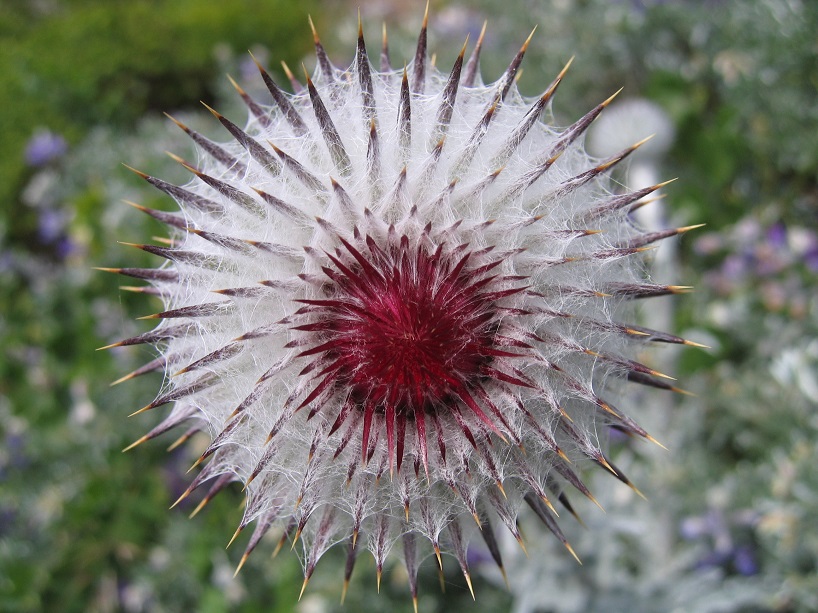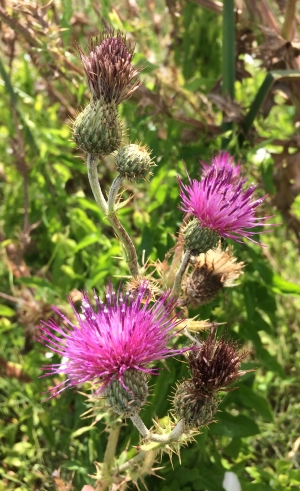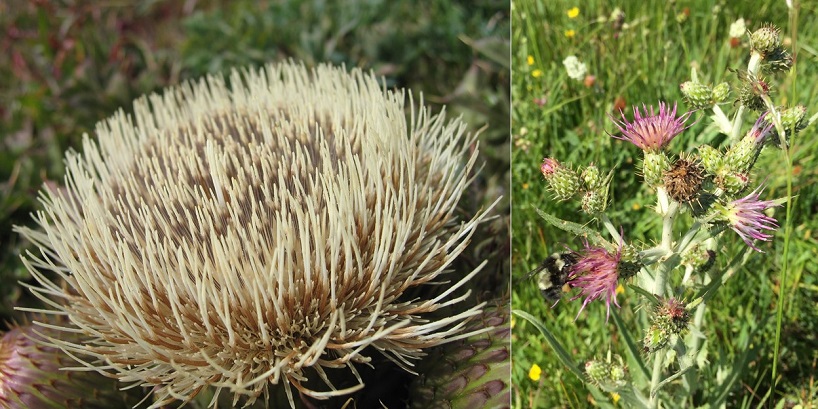
Picture a thistle. What do you see? Do you imagine the yellow star-thistle blanketing dry hillsides in the late summer? Or perhaps the bull thistle, with its fat magenta flower heads and spines on every surface?
We tend to think of thistles as noxious weeds, unwanted invaders, and eyesores. But did you know that California is also home to 19 species of beautiful native thistles, 7 of which are endemic to our state? They may be spiky and sharp, but they are an integral part of many California ecosystems, from ocean dunes to mountain peaks. Thistles also produce a lot of nectar which makes them an important food source for native bumblebees, butterflies, and other pollinators!
Most of the native plants we would call thistles fall into the genus Cirsium, in the Asteraceae family. Some species of Eryngium also have the common name “coyote thistle” as they have a spiky growth form and similar-looking flowers, but they’re actually in the carrot family (Apiaceae) instead of Asteraceae!
 Of the 14 Cirsiums that are CNPS-listed as rare species, 4 are federally endangered and 1 is extinct. The one extinct thistle, known as the Lost Thistle (Cirsium praeteriens), was collected near Palo Alto by J. W. Congdon in 1897 and 1901 but it was never seen again.
Of the 14 Cirsiums that are CNPS-listed as rare species, 4 are federally endangered and 1 is extinct. The one extinct thistle, known as the Lost Thistle (Cirsium praeteriens), was collected near Palo Alto by J. W. Congdon in 1897 and 1901 but it was never seen again.
CNDDB staff had the opportunity to accompany the CDFW drone team and  Native Plant Program to look for the federally endangered Suisun thistle on CDFW lands in the Delta. There are only a few occurrences of the Suisun thistle, and it grows in salt marshes with thick vegetation that makes it difficult to thoroughly survey on foot. However, drones can fly overhead and thoroughly photograph a site from the air. More and more botanists are turning to drones to survey areas inaccessible to humans, and drone surveys in Hawaii even rediscovered a plant
Native Plant Program to look for the federally endangered Suisun thistle on CDFW lands in the Delta. There are only a few occurrences of the Suisun thistle, and it grows in salt marshes with thick vegetation that makes it difficult to thoroughly survey on foot. However, drones can fly overhead and thoroughly photograph a site from the air. More and more botanists are turning to drones to survey areas inaccessible to humans, and drone surveys in Hawaii even rediscovered a plant  thought to be extinct. We flew drones over a known population as well as a nearby marsh with suitable habitat, to see if it is possible to use the drones to identify new Suisun thistle populations, or to monitor existing populations. The results of this survey are still being analyzed, but if successful it could be an exciting new tool for plant conservation in California.
thought to be extinct. We flew drones over a known population as well as a nearby marsh with suitable habitat, to see if it is possible to use the drones to identify new Suisun thistle populations, or to monitor existing populations. The results of this survey are still being analyzed, but if successful it could be an exciting new tool for plant conservation in California.
If you’d like to learn more about these misunderstood plants, check out the Xerces Society’s  native thistle guide for more information about the native thistles of North America and their conservation value.
native thistle guide for more information about the native thistles of North America and their conservation value.
As always, if you spot one of our rare native thistles, fill out an  Online Field Survey Form and snap a photo for a chance for your picture to be featured as our Photo of the Month!
Online Field Survey Form and snap a photo for a chance for your picture to be featured as our Photo of the Month!

Photo caption: Top: Western thistle (Cirsium occidentale) flower head; Middle right: The federally endangered Suisun thistle (Cirsium hydrophilum var. hydrophilum) grows in Delta salt marshes; Bottom left: Brownie thistle (Cirsium quercetorum) in bloom; Bottom right: Native bumblebee pollinating a Brewer’s swamp thistle (Cirsium douglasii var. breweri)
Photo credit: Top: Kristi Lazar; Middle right: Rachel Powell; Bottom left: Kristi Lazar; Bottom right: Katie Ferguson